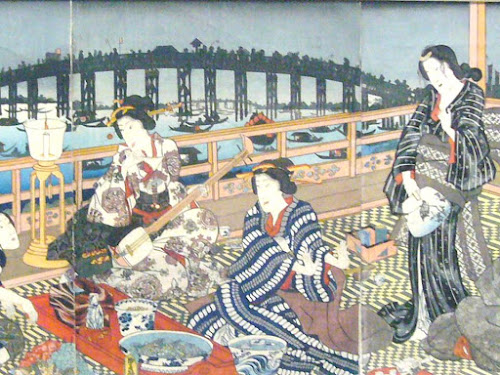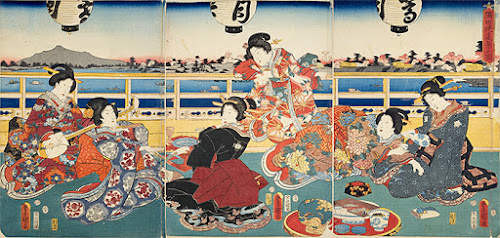April; visiting Tsukuba shrine
There were several jobs related to O-shishigari. They had meetings, and they also signed and sealed on official documents. However, their ordinary daily life resumed.
Three people visited Mt.Tsukuba, which is 43km away and 877m high, in order to visit Tsukuba-san shrine. It was before farming season, and they could have a three day trip. I think it was a great pastime for them.
By the way, master’s father visited Edo and stayed for four nights. What do you think he did in Edo?
・4月(筑波参詣)
まだ、鹿狩りの手続きがあり、寄合や請書調印がなされるが、普通の日々が再開する。
江戸からの来客、筑波への参詣(孝助ら3名、3泊)、農繁期前で楽しかったであろう。流山からは筑波山が見える。
父は、2日に出府、4泊して戻る。江戸で何をされているのか。
Uruu-April; rice planting, farming season had started
We used a lunar calendar at that time, so about every three years, we had thirteen months in a year. This month was added to April and called Uruu-April.
His mother got a kyu or a kind of massage in Yoshikawa which was 8km away. I think she went there to relieve her body after rice planting.
On the other hand, his father went to Edo again on the 17th. It was a busy season for them because of rice planting. He stayed for 17 days in Edo, and returned on the 4th of May after rice planting season. Edo was a big city and there were a lot of entertainment. Do you think he enjoyed them?
この中でも、母は吉川(約8km先)で灸治をし、父は17日から出府している。
5/4まで17日間の出府である。江戸で何をしているのか。
May; horse capturing
Warrior horses for the shogun were bred near the village. The pasture was broad, the length was 43km and the max width was 6km. Excellent horses had been bred since hundred years ago. Horses were captured every year.
村の近くには、将軍家用の軍馬を育てる牧場があった。小金牧は、直線距離で43km、最大幅が6kmあったといわれており、宇治川の先陣争いに出てくる「いけずき」、「するすみ」もこの土地の産らしい。(おの・つよし、イラストまつど物語)
先月は25日に、野馬追の人足12人と、宰領1人を出し、2泊して帰村している。当月8日に、「野馬追人足役勘定酒」として酒5枡と豆腐一丁半が出たようだ。夜に酒三枡を追加している。人足も参加しただろうから、馬を捕えた話を肴にか、大盛り上がりだろう。
引き続き、18日から四日間、野馬捕りに人足5人と宰領1人を出している。そして、23日には、主が子供と思われる愛輔を連れて見物に行っている。奈良には鹿の角を狩る行事があるが、そのように盛り上がるのか。
May; Edo (Tokyo) stay of his father
・5月(その2:父、出府の楽しみ)
父が前月17日に出府、5/4まで17日間の滞在となる。同行した重三郎は翌日に帰村。
参照: Life in Edo, old Tokyo (1959) 江戸生活辞典
・9/22~10/15、24日間、10/9に金子を送る、同行の重三郎は3泊
・12/4~12/17、13日間、12/14に金子依頼の飛脚が来るも、でき難き旨、返書する。
Yoshino’s daily life 02, Life and fun of Yoshino family 吉野家の暮らしと楽しみ
Next post : One of the most important ritual and annual event in Japan
Bon 盆
Previous post :"Kou" which was a popular gathering based on religion at that time
Kou in Nagareyama (published in 1991) 流山の講
There were several jobs related to O-shishigari. They had meetings, and they also signed and sealed on official documents. However, their ordinary daily life resumed.
Three people visited Mt.Tsukuba, which is 43km away and 877m high, in order to visit Tsukuba-san shrine. It was before farming season, and they could have a three day trip. I think it was a great pastime for them.
By the way, master’s father visited Edo and stayed for four nights. What do you think he did in Edo?
 |
| Mt.Tsukuba(水海道からの筑波山) |
・4月(筑波参詣)
まだ、鹿狩りの手続きがあり、寄合や請書調印がなされるが、普通の日々が再開する。
江戸からの来客、筑波への参詣(孝助ら3名、3泊)、農繁期前で楽しかったであろう。流山からは筑波山が見える。
父は、2日に出府、4泊して戻る。江戸で何をされているのか。
Uruu-April; rice planting, farming season had started
We used a lunar calendar at that time, so about every three years, we had thirteen months in a year. This month was added to April and called Uruu-April.
Since the 16th, rice planting had
started. It was hard work because they must bend their back to plant rice.
Farmers were busy because they must plant during a specified period. Nowadays machines
are used.
Rice
planting in the famous mountainous area, Gokayama (五箇山の田植)
http://blog.livedoor.jp/nagu0223/archives/51421291.html |
| 日立市郷土博物館 |
His mother got a kyu or a kind of massage in Yoshikawa which was 8km away. I think she went there to relieve her body after rice planting.
On the other hand, his father went to Edo again on the 17th. It was a busy season for them because of rice planting. He stayed for 17 days in Edo, and returned on the 4th of May after rice planting season. Edo was a big city and there were a lot of entertainment. Do you think he enjoyed them?
・閏4月(田植、農繁期に)
16日から田植が始まる。人員を動員し、忙しい。この中でも、母は吉川(約8km先)で灸治をし、父は17日から出府している。
5/4まで17日間の出府である。江戸で何をしているのか。
May; horse capturing
Warrior horses for the shogun were bred near the village. The pasture was broad, the length was 43km and the max width was 6km. Excellent horses had been bred since hundred years ago. Horses were captured every year.
The master dispatched a supervisor
and 12 farmers for the event on the 25th of the last month. They
stayed for two nights, then got back to the village.
On the 8th of this month, five bottles of sake and tofu or soybean curd were presented to them for their party. The master added three bottles of sake at night. I guess that farmers who participated in the event and villagers joined the party. They might have enjoyed the story of capturing horses. I am sure it was a joyful feast. He dispatched a supervisor and five farmers for the event from the 18th to the 21st again.
He also went to see the event with a child on the 23rd. It interests me because the event looked like a kind of show. There is a deer capturing event to cut the horn in Nara.
・5月(その1:野馬捕り)On the 8th of this month, five bottles of sake and tofu or soybean curd were presented to them for their party. The master added three bottles of sake at night. I guess that farmers who participated in the event and villagers joined the party. They might have enjoyed the story of capturing horses. I am sure it was a joyful feast. He dispatched a supervisor and five farmers for the event from the 18th to the 21st again.
He also went to see the event with a child on the 23rd. It interests me because the event looked like a kind of show. There is a deer capturing event to cut the horn in Nara.
Do you
think those two events are similar?
 |
| Horse capturing and the gallery / Nagareyama CityMuseum 野馬捕り |
村の近くには、将軍家用の軍馬を育てる牧場があった。小金牧は、直線距離で43km、最大幅が6kmあったといわれており、宇治川の先陣争いに出てくる「いけずき」、「するすみ」もこの土地の産らしい。(おの・つよし、イラストまつど物語)
先月は25日に、野馬追の人足12人と、宰領1人を出し、2泊して帰村している。当月8日に、「野馬追人足役勘定酒」として酒5枡と豆腐一丁半が出たようだ。夜に酒三枡を追加している。人足も参加しただろうから、馬を捕えた話を肴にか、大盛り上がりだろう。
引き続き、18日から四日間、野馬捕りに人足5人と宰領1人を出している。そして、23日には、主が子供と思われる愛輔を連れて見物に行っている。奈良には鹿の角を狩る行事があるが、そのように盛り上がるのか。
The master’s father returned from
Edo on the 4th. The master borrowed money from a shop on the 11th.
I am not sure it was relevant to his father’s trip to Edo.
Edo was already a very attractive city at that time. Ennichi or a kind of festival with stalls was held almost every night. There were also bird cafes. Furthermore, there were part-time mistresses for the people who came from rural areas. So I understand why he wanted to stay in Edo.
Reference: Life in Edo, old Tokyo (1959) 江戸生活辞典
His father visited Edo often this year.
- From the 22nd of July to 11th of August, 16 days after Obon festival
- From the 22nd of September to 15th of October, 24 days. The master sent money to him. The helper accompanied for three days.
- From the 4th of December to 17th of December, 13 days. The father sent the messenger to the master in order to borrow money, but the master refused the offer.
The master might have been bothered and might not have taken care of his father.
In the case of the master’s visit to Edo, it was usually a two-day trip. It was even one day trip sometimes.
Edo city, Kabuki theater【江戸の賑わい、歌舞伎の顔見世】
http://www2.ntj.jac.go.jp/dglib/modules/kabuki_dic/entry.php?entryid=1057Edo was already a very attractive city at that time. Ennichi or a kind of festival with stalls was held almost every night. There were also bird cafes. Furthermore, there were part-time mistresses for the people who came from rural areas. So I understand why he wanted to stay in Edo.
 |
| Painting of Edo, 江戸東京博物館 |
- From the 22nd of July to 11th of August, 16 days after Obon festival
- From the 22nd of September to 15th of October, 24 days. The master sent money to him. The helper accompanied for three days.
- From the 4th of December to 17th of December, 13 days. The father sent the messenger to the master in order to borrow money, but the master refused the offer.
The master might have been bothered and might not have taken care of his father.
In the case of the master’s visit to Edo, it was usually a two-day trip. It was even one day trip sometimes.
 |
Enjoy the party beside Sumida river in Edo、隅田堤遠景之図(豊国)
http://www.ndl.go.jp/landmarks/details/detail326.html?keywords=cherry-blossom |
・5月(その2:父、出府の楽しみ)
父が前月17日に出府、5/4まで17日間の滞在となる。同行した重三郎は翌日に帰村。
一方、11日に、流山の商店・樽屋から3両借用している。
当時の江戸は、毎日縁日があり皆がでかけるだけでなく、バードカフェとも言える花鳥茶屋から、数人でシェアできる安囲いという愛人まである始末。私としては、彼が居つきたい気持ちは分かる。
父の出府は、次のように続く。
・7/22~8/11、16日間、お盆前のあと・9/22~10/15、24日間、10/9に金子を送る、同行の重三郎は3泊
・12/4~12/17、13日間、12/14に金子依頼の飛脚が来るも、でき難き旨、返書する。
主はあきれて、父親の気ままさに取り合わないようにしたようだ。
主の出府は、一泊、日帰りもある。
Previous post about Yoshino's diary: Yoshino’s daily life 04, March in 1849 (嘉永2年)
Next post : One of the most important ritual and annual event in Japan
Bon 盆
Previous post :"Kou" which was a popular gathering based on religion at that time
Kou in Nagareyama (published in 1991) 流山の講
Comments
Post a Comment